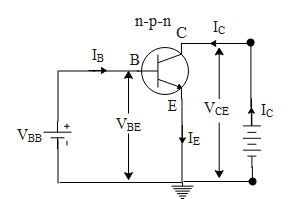
The input characteristics of a transistor in CE mode is the graph obtained by plotting
a) ${{I}_{B}}$ against ${{V}_{BE}}$ at constant ${{V}_{CE}}$
b) ${{I}_{B}}$ against ${{V}_{CE}}$ at constant ${{V}_{BE}}$
c) ${{I}_{B}}$ against ${{I}_{C}}$ at constant ${{V}_{CE}}$
d) ${{I}_{V}}$ against ${{I}_{C}}$ at constant ${{V}_{BE}}$
Answer
576.3k+ views
Hint: The common emitter characteristics are the graphs drawn between voltages and currents for a transistor when its emitter is taken as a common terminal and grounded, base is the input terminal and collector is the output terminal. The input characteristics are studied by plotting the graph of the input current and the input voltage. Hence we will see For CE mode how the transistor is arranged and accordingly come to an answer of the above question.
Complete answer:

In the above diagram we can see that the n-p-n transistor is connected in common emitter configuration. There are three types of curves that are studied for the above configuration. The input characteristics , the output characteristics and transfer characteristics. The input characteristics are studied by plotting graphs showing variation of base current ${{I}_{B}}$ with base-emitter voltage ${{V}_{BE}}$ at constant collector-emitter voltage ${{V}_{CE}}$ is called the input characteristics of the transistor.
Hence from the above information we can conclude that the correct answer of the above question is option a.
So, the correct answer is “Option a”.
Note: A graph showing variation of the collector current ${{I}_{C}}$ with collector-emitter voltage ${{V}_{CE}}$ at constant base current ${{I}_{B}}$ is called the output characteristics of the transistor. Similarly, A graph showing variation of collector current ${{I}_{C}}$ with the base current ${{I}_{B}}$ at constant collector-emitter voltage ${{V}_{CE}}$ is called the transfer characteristic of the n-p-n transistor. These characteristics are studied and various applications of transistors are harnessed.
Complete answer:

In the above diagram we can see that the n-p-n transistor is connected in common emitter configuration. There are three types of curves that are studied for the above configuration. The input characteristics , the output characteristics and transfer characteristics. The input characteristics are studied by plotting graphs showing variation of base current ${{I}_{B}}$ with base-emitter voltage ${{V}_{BE}}$ at constant collector-emitter voltage ${{V}_{CE}}$ is called the input characteristics of the transistor.
Hence from the above information we can conclude that the correct answer of the above question is option a.
So, the correct answer is “Option a”.
Note: A graph showing variation of the collector current ${{I}_{C}}$ with collector-emitter voltage ${{V}_{CE}}$ at constant base current ${{I}_{B}}$ is called the output characteristics of the transistor. Similarly, A graph showing variation of collector current ${{I}_{C}}$ with the base current ${{I}_{B}}$ at constant collector-emitter voltage ${{V}_{CE}}$ is called the transfer characteristic of the n-p-n transistor. These characteristics are studied and various applications of transistors are harnessed.
Recently Updated Pages
Master Class 11 Accountancy: Engaging Questions & Answers for Success

Master Class 11 Science: Engaging Questions & Answers for Success

Master Class 11 Business Studies: Engaging Questions & Answers for Success

Master Class 11 English: Engaging Questions & Answers for Success

Master Class 11 Computer Science: Engaging Questions & Answers for Success

Master Class 9 General Knowledge: Engaging Questions & Answers for Success

Trending doubts
Which are the Top 10 Largest Countries of the World?

Differentiate between insitu conservation and exsitu class 12 biology CBSE

Draw a labelled sketch of the human eye class 12 physics CBSE

State the principle of an ac generator and explain class 12 physics CBSE

Give 10 examples of unisexual and bisexual flowers

Sketch the electric field lines in case of an electric class 12 physics CBSE




